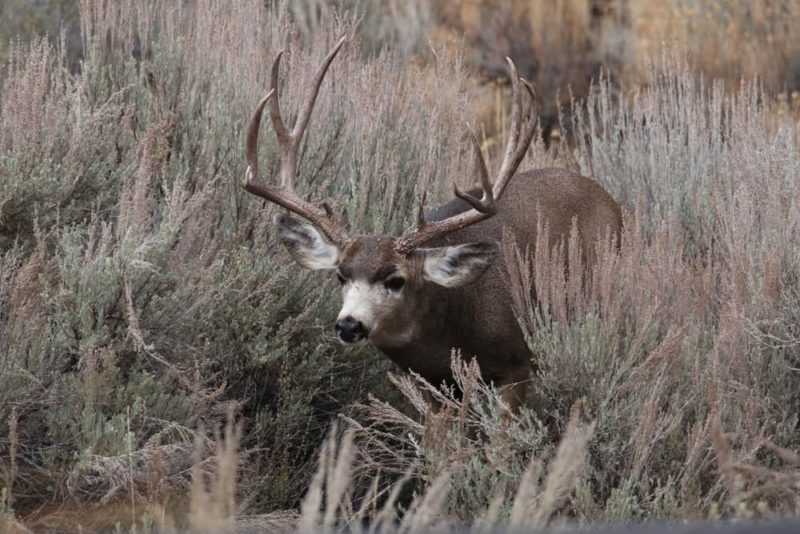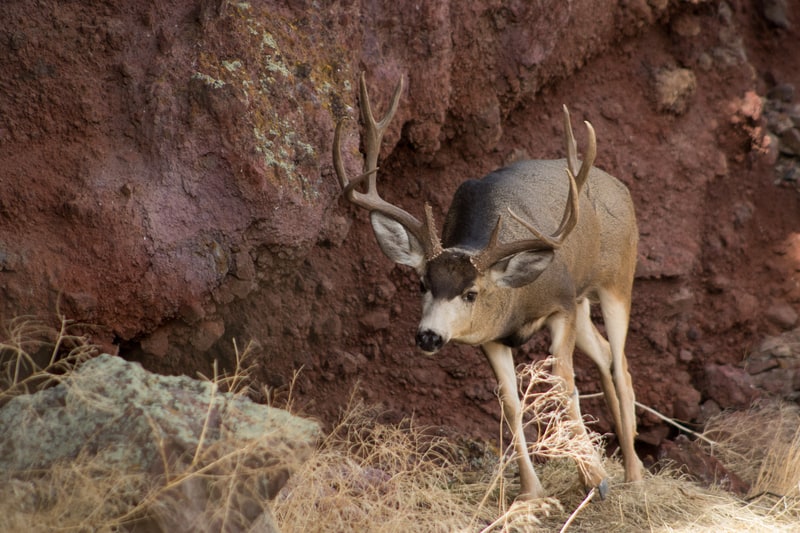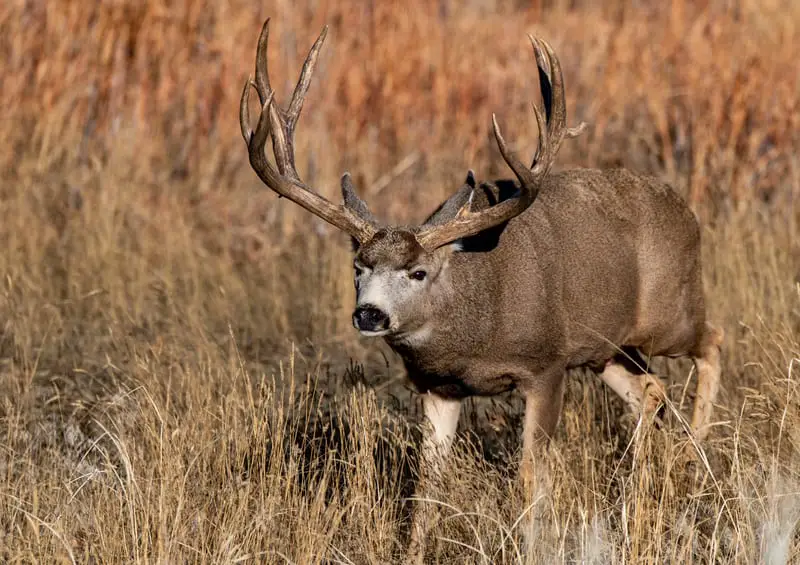The Mule Deer is an iconic big game animal of western North America. The following article will inform you of a Mule Deer’s physical characteristics, its sub-species. Their habits and their range.
Characteristics
They’re slightly larger than White-Tail Deer on average. They are tan in the summer and grey in the fall and winter. They have a white rump patch and a white, black-tipped tail that is slender compared to that of a White-Tail. A Mule Deer buck’s antlers differ from those of a White-Tail in that they fork into two main beams, whereas the points on a whitetail’s antlers all branch from one main beam. Another defining feature is their ears. As the name implies, they have large ears like those of a mule. Mule deer also run with a hopping, bounding gate where all four feet leave the ground at the same time called stotting. This is particular only to their species. Also, see

Habitat
Mule Deer thrive in the sagebrush-covered high desert and mountain country of the American West. They also live in the arid desert country of the American southwest and Mexico. Additionally, you can find mule deer out on the Western Great Plains in the United States and up into the prairies of southern Manitoba, Saskatchewan, and Alberta.
Mule Deer are, for the most part, browsers. This means they feed on the leaves, buds, twigs, and stems of woody and herbaceous plants. Their digestive system isn’t such that they can do well in a grass-only environment. Their rumen doesn’t have enough capacity to digest large amounts of grass like cattle or elk.
Range
Mule Deer are native to western North America. Their range begins in the Yukon and Northwest Territories of Canada in the north. The southern boundary of their range is Zacatecas, Durango, and Baja California Sur in Mexico. They also live from California all the way up through the coastal mountains of British Columbia in the west to the western Great Plains in the east.
Mule Deer SubSpecies
- Rocky mountain Mule Deer– Rocky Mountain mule deer are found in western and central North America from Northern New Mexico and Arizona north to the Yukon.
- California Mule Deer– The California Mule Deer lives in Northern and central California from the California Coastal Prairie to the inner coastal mountains such as the Sierra Nevada. They prefer rolling hill type terrain.
- Cedros Island Mule Deer– Cedros Island Mule Deer live on Cedros Island which is in the Pacific off of Baja California. There are only about 50 Cedros Island Mule Deer left in existence.
- Desert Mule Deer– Desert Mule Deer, range across the desert southwest from west Texas across New Mexico and Arizona. They also live in northwestern Mexico. Desert mule Deer are slightly smaller than Rocky Mountain Mule deer.
- Southern Mule Deer-Southern Mule Deer live in extreme southern California and Baja California.
- Peninsula Mule Deer– Peninsula Mule Deer live in Baja California Sur. They are the only Deer found in Baja California Sur. Therefore they cannot be confused with any other species.
- Tiburon Island Mule Deer– Tiburon Island Mule Deer are only found on Tiburon Island which is the largest island in the Gulf of California. These Deer are shorter bodied and darker caped than the Mule deer found on the Sonoran mainland. Tiburon Island is part of a reservation belonging to the Seri Indians.
- Inyo Mule Deer– The Inyo Mule Deer lives in California along the eastern slope of the Sierra Nevada Mountains . They range in Inyo and Mono counties. They resemble Rocky Mountain Mule Deer in every way aside from being a bit smaller.
Mule Deer Population By The State And Province
- Alaska-The state of Alaska is not traditional Mule Deer range, however there have been enough sightings of these animals in recent years that the state has added them as a species legal to take during deer season. The following quote is from the Alaska Department of Fish and Game website. “ Alaska, mule deer do not have an established traditional range, but sightings are reported from the eastern Interior to northern Southeast Alaska. All have likely immigrated from within the species’ current range in Yukon, Canada. A mule deer was killed by a vehicle near Fairbanks in May, 2017; in 2013, three were reported north of Delta Junction; and a mule deer was photographed in July 2016 near the Fort Knox gold mine near Fairbanks. Canada’s Yukon Territory has an established mule deer population, and therefore mule deer naturally migrate west through valleys, forests and tundra habitats. Mule deer have also been seen in Southeast Alaska, with sightings reported near Haines and Skagway as recently as spring of 2019.” Source
- Washington– There are around 90,000 Mule deer in the state of Washington.
- Oregon– In Oregon there are 225,000 to 235,000 mule deer.
- California– The only deer population estimate I can find for the state of California is for the total deer population. This of coarse, includes Columbian Black Tails as well as Mule Deer. As of 2017 the total deer population estimate for the state of California was 532,621 animals.
- Arizona– The state of Arizona estimates it’s Mule Deer population to be between 85,000 and 100,000 animals.
- Nevada– Nevada has around 92,000 Mule Deer.
- Utah– Utah has just over 370,000 Mule Deer.
- Idaho– I can not find a hard estimate on Idaho Mule deer numbers. from 2009 through 2019 the average yearly Mule Deer harvest was around 28,000 animals though.
- Wyoming– I can not find any hard numbers on the Wyoming Mule Deer population . The total Mule Deer harvest for the state of Wyoming in 2018 was 26,141 animals though . This suggests that the state has a robust Mule Deer population.
- North Dakota– North Dakota has 2,364 mule deer.
- Montana– As of 2018 Montana had around 334,955 Mule Deer.
- South Dakota– South Dakota has around 60,000 mule deer.
- Nebraska– Nebraska has around 133,000 Mule deer
- Kansas- I can not find any hard data on Kansas Mule Deer numbers however as of 2020 the state of Kansas had an estimated 700,000 deer in total. The majority of these are White Tails. I also obtained the following quote from The Kansas Fish and Game web site. “Mule Deer are restricted to the western one-third of the state, primarily on the High Plains, Smoky Hills, and Red Hills regions. As you travel west to east, mule deer are less abundant, and whitetail numbers increase”. Source
- Oklahoma- The state of Oklahoma has around 2000 mule Deer.
- Texas– Mule deer populations fluctuate between 150,000 and 250,000. Their population fluctuates depending on current habitat conditions.
Canadian Mule Deer
- British Columbia– British Columbia has 165,000 Mule Deer
- Alberta– Alberta has around 133,000 Mule Deer.
- Saskatchewan– Saskatchewan is famous for it’s trophy Mule Deer bucks. However, there is no data online as to the population within the province.
- Manitoba– There are Mule Deer in Manitoba. They are primarily in the extreme southwest corner of the province. Total population is unknown.
- Yukon– The total Mule Deer population in the Yukon has not been determined
- Northwest Territories– The total Mule Deer population in the Northwest Territories has not been determined.
Mexican Mule Deer
There is no hard population data for each state; however, the following Mexican states have populations of Mule deer.
- Baja California
- Baja California Sur
- Sonora
- Chihuahua
- Coahuila
- Nuevo Leon
- Zacatecas

In particular, Sonora is world-renowned for its giant racked Desert Mule deer bucks.
In Conclusion
Whether you are a hunter or just an enthusiast of the great outdoors, you need to get out find yourself somewhere in Mule Deer country. Mule deer are one of North America’s premier big game animals. The more people who develop an appreciation for them and the habitat that they live in, the better the prospects are that we will preserve their populations for future generations to enjoy.
Recent Posts
The only venomous snakes in Washington State are Northern Pacific Rattlesnakes. The Northern Pacific Rattlesnake (Crotalus oreganus oreganus) is a sub-species of the Western Rattlesnake. Anyone...
Skunks are not classified as true hibernators. But they go into a state of torpor when the weather gets cold. Skunks are light sleep hibernators, along with opossums, bears, and raccoons. ...

